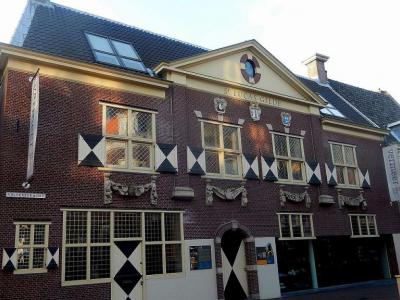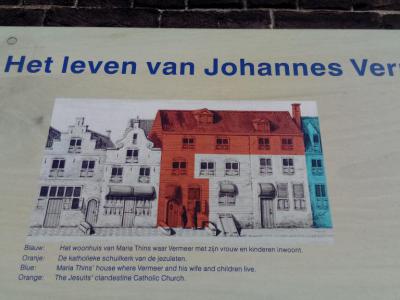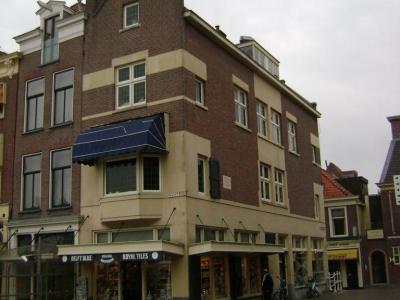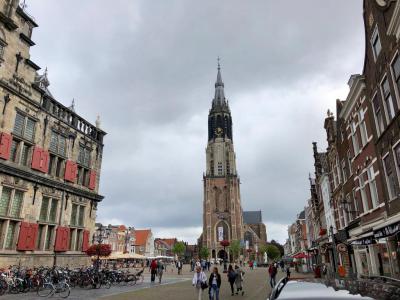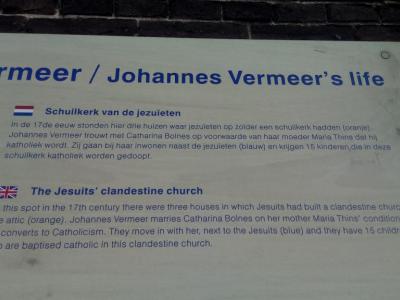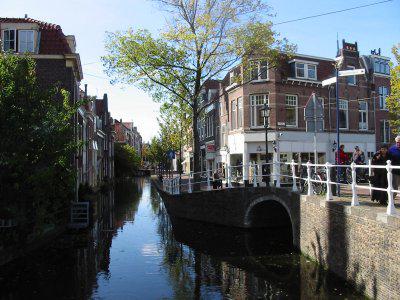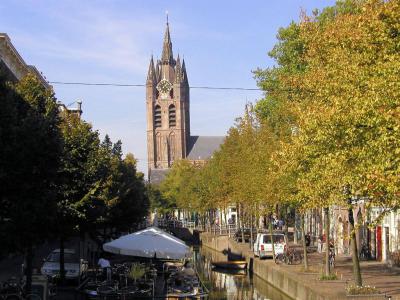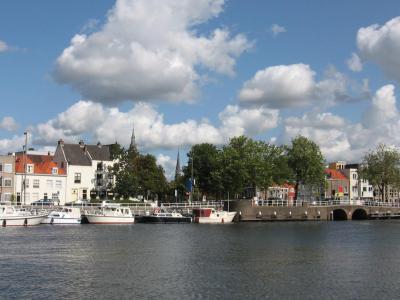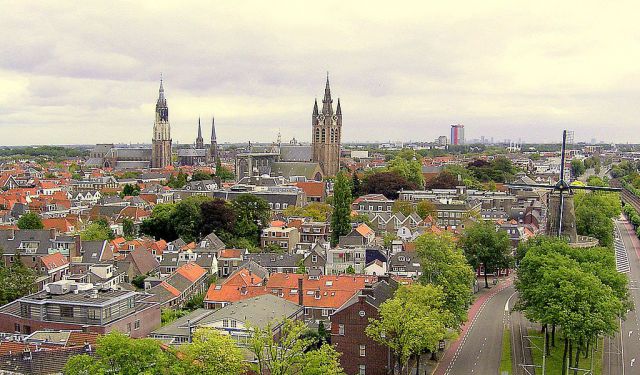Johannes Vermeer's Delft Walk (Self Guided), Delft
The Dutch painter Johannes Vermeer (1632 – 1675) spent almost his entire life in his home town, Delft. He left only a few times, towards the end, on the short trips to Amsterdam and The Hague.
The old Delft undoubtedly was one of the most typical little towns of the 17th-century Netherlands, and as such, was rather picturesque. Just like any other Dutch place, Delft was dominated by its towers: the Oude Kerk (Old Church) and the Nieuwe Kerk (New Church), which, together with many smaller spires of the earlier monasteries and chapels, gave the town its prickly silhouette.
Luckily, the heart of Delft today looks pretty much as it was back in Vermeer's day, with a good portion of architectural heritage, remembering the artist, still in place. There are acres of houses, churches, canals and squares that still stand in their full glory and can take you straight back into Vermeer's world.
Among them are the house where the painter was born – at Voldersgracht 26 (the former inn named "The Flying Fox"); the house where he lived – at Oude Langendijk; and Voldersgracht Street where he painted “The Little Street”. Another notable location is the Kolk Harbor, or De Kolk, depicted in Vermeer's "View of Delft" painting.
But undoubtedly, the best place to start a journey into the artist's life is the Vermeer Centre – housed in the historic Saint Luke Guild building. To see first-hand the locations that played an important role in the life of Johannes Vermeer, take this self-guided walking tour.
The old Delft undoubtedly was one of the most typical little towns of the 17th-century Netherlands, and as such, was rather picturesque. Just like any other Dutch place, Delft was dominated by its towers: the Oude Kerk (Old Church) and the Nieuwe Kerk (New Church), which, together with many smaller spires of the earlier monasteries and chapels, gave the town its prickly silhouette.
Luckily, the heart of Delft today looks pretty much as it was back in Vermeer's day, with a good portion of architectural heritage, remembering the artist, still in place. There are acres of houses, churches, canals and squares that still stand in their full glory and can take you straight back into Vermeer's world.
Among them are the house where the painter was born – at Voldersgracht 26 (the former inn named "The Flying Fox"); the house where he lived – at Oude Langendijk; and Voldersgracht Street where he painted “The Little Street”. Another notable location is the Kolk Harbor, or De Kolk, depicted in Vermeer's "View of Delft" painting.
But undoubtedly, the best place to start a journey into the artist's life is the Vermeer Centre – housed in the historic Saint Luke Guild building. To see first-hand the locations that played an important role in the life of Johannes Vermeer, take this self-guided walking tour.
How it works: Download the app "GPSmyCity: Walks in 1K+ Cities" from Apple App Store or Google Play Store to your mobile phone or tablet. The app turns your mobile device into a personal tour guide and its built-in GPS navigation functions guide you from one tour stop to next. The app works offline, so no data plan is needed when traveling abroad.
Johannes Vermeer's Delft Walk Map
Guide Name: Johannes Vermeer's Delft Walk
Guide Location: Netherlands » Delft (See other walking tours in Delft)
Guide Type: Self-guided Walking Tour (Sightseeing)
# of Attractions: 8
Tour Duration: 1 Hour(s)
Travel Distance: 2.0 Km or 1.2 Miles
Author: sabrina
Sight(s) Featured in This Guide:
Guide Location: Netherlands » Delft (See other walking tours in Delft)
Guide Type: Self-guided Walking Tour (Sightseeing)
# of Attractions: 8
Tour Duration: 1 Hour(s)
Travel Distance: 2.0 Km or 1.2 Miles
Author: sabrina
Sight(s) Featured in This Guide:
- Vermeer Centre
- Voldersgracht 26. Vermeer's Birthplace
- Mechelen Inn
- Nieuwe Kerk (New Church)
- Oude Langendijk (Vermeer Studio and Residence)
- Voldersgracht Street
- Oude Kerk (Old Church)
- De Kolk (Kolk Harbor)
1) Vermeer Centre (must see)
The Vermeer Centre in Delft is an information center dedicated to one of the most prominent Dutch painters of the Golden Age, Johannes Vermeer. Opened in 2007 and run entirely by volunteers, this popular cultural venue is found in the historic former Saint Luke Guild House, and is the only place in the world where all 37 paintings by Vermeer can be seen as full-size reproductions.
Pursuant to its objective – to disseminate knowledge about Delft during the lifetime of Vermeer (1632 – 1675), the center works with local archaeological groups and heritage organizations. Although it acts as a museum, the Vermeer Centre does not own the displayed items.
The exhibits are spread on three floors, including the basement, allowing visitors an insight into Vermeer's life reflected in his works as well as those of his contemporaries, much as to learn about the events that occurred during his lifetime.
Other than the paintings, the permanent exhibition comprises various media including a studio which explores methods of Vermeer's work – his attention to color, light and perspective. Here, visitors have the opportunity to pose for a picture as Lady Writing a Letter with her Maid, as well as to see a video on a 12-meter-wide screen highlighting the relationship between the artist and the city of Delft.
On the ground floor you can find a small gift store and a bookshop. The exhibition "Vermeer's Messages of Love" on the top floor examines symbolism in his paintings.
Tip:
For individual visitors there is a free audio tour.
Pursuant to its objective – to disseminate knowledge about Delft during the lifetime of Vermeer (1632 – 1675), the center works with local archaeological groups and heritage organizations. Although it acts as a museum, the Vermeer Centre does not own the displayed items.
The exhibits are spread on three floors, including the basement, allowing visitors an insight into Vermeer's life reflected in his works as well as those of his contemporaries, much as to learn about the events that occurred during his lifetime.
Other than the paintings, the permanent exhibition comprises various media including a studio which explores methods of Vermeer's work – his attention to color, light and perspective. Here, visitors have the opportunity to pose for a picture as Lady Writing a Letter with her Maid, as well as to see a video on a 12-meter-wide screen highlighting the relationship between the artist and the city of Delft.
On the ground floor you can find a small gift store and a bookshop. The exhibition "Vermeer's Messages of Love" on the top floor examines symbolism in his paintings.
Tip:
For individual visitors there is a free audio tour.
2) Voldersgracht 26. Vermeer's Birthplace
In 1631, Vermeer's father, Reijnier Janszoon, (who in 1640, for unknown reason, adopted the surname "Vermeer") rented a property on Voldersgracht. Here, in a bid to improve his family's financial standing, he started an inn, which he called "de Vliegende Vos" (The Flying Fox). The inn's name eventually proved symbolic, as in 1652 Reynier changed his own first name to Vos.
Municipal records suggest that Johannes Vermeer was born at 26 Voldersgracht in 1632 and lived here, in The Flying Fox, together with his parents until about 1641.
Eventually, Reijnier started dealing in fine arts, too, in addition to running the inn. Perhaps it was due to this fact – surrounded by paintings and artists who came regularly to eat, drink and talk business with his father, that young Vermeer developed passion for painting.
In 1641, when Vermeer was about nine years old, his father's business expanded with the purchase of yet another, much larger inn on Markt (Market Place), named after the Flemish town Mechelen, upon which the family had left The Flying Fox for good.
Municipal records suggest that Johannes Vermeer was born at 26 Voldersgracht in 1632 and lived here, in The Flying Fox, together with his parents until about 1641.
Eventually, Reijnier started dealing in fine arts, too, in addition to running the inn. Perhaps it was due to this fact – surrounded by paintings and artists who came regularly to eat, drink and talk business with his father, that young Vermeer developed passion for painting.
In 1641, when Vermeer was about nine years old, his father's business expanded with the purchase of yet another, much larger inn on Markt (Market Place), named after the Flemish town Mechelen, upon which the family had left The Flying Fox for good.
3) Mechelen Inn
In 1641, Vermeer's father Reijnier Janszoon Vos bought the large Mechelen Inn on Markt (Market Place). As a tavern – with lodgings to stay overnight – it was much larger than a regular inn. In fact, Mechelen was the largest building in the area – standing on the corner of Oude Manhuissteeg (Old Men's Alley). The six fireplaces the tavern had offers a pretty good idea of its size.
The Inn enjoyed strategic location at the heart of the bustling city, with the Town Hall on one side and the Nieuwe Kerk on the other, and as such was much loved by the locals as a meeting place. Among those who frequented here were distinguished artists like Evert van Aelst, Egbert van der Poel and Leonaert Bramer – the latter being a friend of the Vermeer family, who came regularly for a bit of shop-talk and likely business.
In 1885 the Inn was demolished, to reduce fire hazard, and today no building stands in its place.
In 1955 a memorial tablet was placed on the wall of the adjoining house, at 52 Markt, to mark the spot where Mechelen once stood. Created by the Delft sculptor Johan Bijsterveld, the tablet bears the inscription: "Here stood Mechelen House where the artist Jan Vermeer was born in 1632", which contains two factual mistakes.
Firstly, Vermeer was not born in Mechelen but in the nearby Flying Fox, at 25 Voldersgracht, and only moved here when aged 9. And secondly, Vermeer never used the name Jan. He was baptized Joannis and always signed deeds as Joannes, Joannis or Johannis. Despite criticism, the foundation Delft Binnen De Veste (Delft Within The Ramparts), responsible for the inscription, stuck with the name Jan as more familiar, and so left the plaque as it is.
The Inn enjoyed strategic location at the heart of the bustling city, with the Town Hall on one side and the Nieuwe Kerk on the other, and as such was much loved by the locals as a meeting place. Among those who frequented here were distinguished artists like Evert van Aelst, Egbert van der Poel and Leonaert Bramer – the latter being a friend of the Vermeer family, who came regularly for a bit of shop-talk and likely business.
In 1885 the Inn was demolished, to reduce fire hazard, and today no building stands in its place.
In 1955 a memorial tablet was placed on the wall of the adjoining house, at 52 Markt, to mark the spot where Mechelen once stood. Created by the Delft sculptor Johan Bijsterveld, the tablet bears the inscription: "Here stood Mechelen House where the artist Jan Vermeer was born in 1632", which contains two factual mistakes.
Firstly, Vermeer was not born in Mechelen but in the nearby Flying Fox, at 25 Voldersgracht, and only moved here when aged 9. And secondly, Vermeer never used the name Jan. He was baptized Joannis and always signed deeds as Joannes, Joannis or Johannis. Despite criticism, the foundation Delft Binnen De Veste (Delft Within The Ramparts), responsible for the inscription, stuck with the name Jan as more familiar, and so left the plaque as it is.
4) Nieuwe Kerk (New Church) (must see)
The New Church came after the Old Church. No surprise there. The very first New Church was temporary, made of wood in 1381 and consecrated in 1382. The Gothic stone basilica New Church structure was begun in 1384 and the inner wooden church was disassembled. The church is on the Market Square, opposite the Town Hall.
The tower, designed by Jacob van de Borch, was not started until 1396. It was slow building, finished in 1496. The tower was ill-fated. In May, 1536, a lightning strike on the tower started a blaze that nearly consumed the entire town. The city archives went up in smoke, resulting in the loss of close to all public records before 1536.
Bad luck came back again. 1654 was the year of the Delft Thunderclap. A gunpowder storage magazine in the northeast corner of town exploded. The center of the city was erased and the New Church did not escape damage. All the stained glass windows in the church disintegrated. The next magazine was situated well out of town.
In 1872 the church tower attracted lightning once again. Pierre Cuypers, architect, designed a new tower strengthened with Benteimer sandstone. Pierre also replaced the spire, making the New Church the tallest in the Netherlands after the Dom Tower in Utrecht. The tower can be climbed using no less than 356 steps.
The New Church was a Roman Catholic church named for the Virgin Mary and Saint Ursula of Cologne. The Reformation changed all that in 1572, when the New Church was usurped by the Dutch Reformed Church. In 2004 the Dutch Reformed Church merged with other Protestant churches to form the Protestant Church of the Netherlands.
For centuries, the New Church has been the burial place for members of the House of Orange-Nassau. The first of them, William the Silent, was entombed in a mausoleum in 1584. The latest burial – of Queen Juliana and her husband Prince Bernhard – took place in 2004. The royal family crypt is private and not open to the public.
The native of Delft painter Johannes Vermeer, christened in the New Church on October 31, 1632, had pictured this church's tower in his masterful landscape “View of Delft”. Notably, in his painting the bells are not yet seen. According to the independent Dutch art historian Kees Kaldenbach, the delivery of carillon for the New Church started in 1660 and was completed in the summer of 1661, which corresponds with the dating previously suggested, based on Vermeer's painting.
A historical chronicle says that the 36 bells installed in the New Church were "the latest piece of technology." Their music must have been a source of constant pleasure to Vermeer's ears, who would have heard them every day from his nearby studio.
The tower, designed by Jacob van de Borch, was not started until 1396. It was slow building, finished in 1496. The tower was ill-fated. In May, 1536, a lightning strike on the tower started a blaze that nearly consumed the entire town. The city archives went up in smoke, resulting in the loss of close to all public records before 1536.
Bad luck came back again. 1654 was the year of the Delft Thunderclap. A gunpowder storage magazine in the northeast corner of town exploded. The center of the city was erased and the New Church did not escape damage. All the stained glass windows in the church disintegrated. The next magazine was situated well out of town.
In 1872 the church tower attracted lightning once again. Pierre Cuypers, architect, designed a new tower strengthened with Benteimer sandstone. Pierre also replaced the spire, making the New Church the tallest in the Netherlands after the Dom Tower in Utrecht. The tower can be climbed using no less than 356 steps.
The New Church was a Roman Catholic church named for the Virgin Mary and Saint Ursula of Cologne. The Reformation changed all that in 1572, when the New Church was usurped by the Dutch Reformed Church. In 2004 the Dutch Reformed Church merged with other Protestant churches to form the Protestant Church of the Netherlands.
For centuries, the New Church has been the burial place for members of the House of Orange-Nassau. The first of them, William the Silent, was entombed in a mausoleum in 1584. The latest burial – of Queen Juliana and her husband Prince Bernhard – took place in 2004. The royal family crypt is private and not open to the public.
The native of Delft painter Johannes Vermeer, christened in the New Church on October 31, 1632, had pictured this church's tower in his masterful landscape “View of Delft”. Notably, in his painting the bells are not yet seen. According to the independent Dutch art historian Kees Kaldenbach, the delivery of carillon for the New Church started in 1660 and was completed in the summer of 1661, which corresponds with the dating previously suggested, based on Vermeer's painting.
A historical chronicle says that the 36 bells installed in the New Church were "the latest piece of technology." Their music must have been a source of constant pleasure to Vermeer's ears, who would have heard them every day from his nearby studio.
5) Oude Langendijk (Vermeer Studio and Residence)
According to historical records, by December 1660 Johannes Vermeer had moved in with his mother-in-law (Maria Thins) at her place on Oude Langendijk, at the heart of Delft's Catholic district, colloquially known as the "Papenhoek" (Papists' Corner), near the Nieuwe Kerk.
What exactly prompted his move – prior to which Vermeer, most certainly, had lived in the Mechelen Inn, owned by his father, on Groote Markt (Market Place) – is unknown. It might have been due to his marriage arrangement whereby he agreed to convert to Catholicism, or perhaps was just a matter of finance. Or else, it could have been that Johannes and/or his wife Catharina Thins found Mechelen not suitable for raising children. Whatever the reason, the young family moved into Maria Thins' home when Vermeer was approximately 28 years old.
By that time he had already completed his masterpiece “View of Delft” and began experimenting with indoor subjects, like “The Milkmaid” and “Officer and Laughing Girl”. Once accustomed to his new residence/studio, Vermeer created a series of sublime paintings – so perfect in technique, that some critics described them as "pearl" ones.
In all probability, the Vermeer/Thins dwelling stood on the corner of two streets, Oude Langendijk and the narrow alley of Molenpoort (present day's Jozefstraat). The site of Vermeer's home is now occupied by the 19th-century Maria van Jesse Church. The commemorative plaque, initiated by the Dutch art historian and Vermeer expert Kees Kaldenbach, marks the former house location for those curious.
What exactly prompted his move – prior to which Vermeer, most certainly, had lived in the Mechelen Inn, owned by his father, on Groote Markt (Market Place) – is unknown. It might have been due to his marriage arrangement whereby he agreed to convert to Catholicism, or perhaps was just a matter of finance. Or else, it could have been that Johannes and/or his wife Catharina Thins found Mechelen not suitable for raising children. Whatever the reason, the young family moved into Maria Thins' home when Vermeer was approximately 28 years old.
By that time he had already completed his masterpiece “View of Delft” and began experimenting with indoor subjects, like “The Milkmaid” and “Officer and Laughing Girl”. Once accustomed to his new residence/studio, Vermeer created a series of sublime paintings – so perfect in technique, that some critics described them as "pearl" ones.
In all probability, the Vermeer/Thins dwelling stood on the corner of two streets, Oude Langendijk and the narrow alley of Molenpoort (present day's Jozefstraat). The site of Vermeer's home is now occupied by the 19th-century Maria van Jesse Church. The commemorative plaque, initiated by the Dutch art historian and Vermeer expert Kees Kaldenbach, marks the former house location for those curious.
6) Voldersgracht Street
Voldersgracht is one of Delft’s oldest and most picturesque streets, offering visitors a unique glimpse into the city’s medieval past and vibrant present. Dating back to at least 1348, this historic canal is unlike most others in Delft, as it features a street on one side and houses built directly on the water on the other. Its name comes from the cloth fullers who once worked here during the Middle Ages, using the canal to wash away the remnants of their trade.
Located just steps from the bustling Markt Square and the iconic Nieuwe Kerk, Voldersgracht combines historic charm with modern life. Strolling along its narrow, canal-lined path, visitors will encounter elegant 17th-century architecture, quaint bridges, boutique shops, and cozy cafés that invite you to pause and soak in the relaxed Delft atmosphere.
Art enthusiasts will find a special connection here: several art historians have speculated that Voldersgracht may have inspired Johannes Vermeer’s famous painting The Little Street. Vermeer’s father once ran an inn nearby, and the artist himself was affiliated with the St. Lucas Guild, which stood on this very street. Today, the reconstructed guild building houses the Vermeer Centrum Delft, dedicated to his life and works.
Located just steps from the bustling Markt Square and the iconic Nieuwe Kerk, Voldersgracht combines historic charm with modern life. Strolling along its narrow, canal-lined path, visitors will encounter elegant 17th-century architecture, quaint bridges, boutique shops, and cozy cafés that invite you to pause and soak in the relaxed Delft atmosphere.
Art enthusiasts will find a special connection here: several art historians have speculated that Voldersgracht may have inspired Johannes Vermeer’s famous painting The Little Street. Vermeer’s father once ran an inn nearby, and the artist himself was affiliated with the St. Lucas Guild, which stood on this very street. Today, the reconstructed guild building houses the Vermeer Centrum Delft, dedicated to his life and works.
7) Oude Kerk (Old Church) (must see)
The Old Church, nicknamed "Old John," is a Gothic Protestant temple in Delft whose most recognizable feature is a 75-meter-high brick tower leaning about two meters from the vertical. The layout followed that of a traditional basilica, with a nave flanked by two smaller aisles. The church was founded as Saint Bartholomew's in 1246 on the site previously occupied by other temples for two centuries.
There are three pipe organs inside the church: the main one (installed in 1857), the north aisle (installed in 1873), and the choir (installed in 1770). The most massive bell in the tower, cast in 1570 and called Trinitasklok or Bourdon, weighs nearly nine tonnes. Because of its strong and potentially damaging vibrations, it is rung only on special occasions, such as the burial of a Dutch royal family member in the nearby New Church.
The Old Church is also notable as the last resting place of Johannes Vermeer – the artist was buried here on 15th December 1675 in a family crypt in the northern transept, bought by his mother-in-law Maria Thins in 1661. His grave remained unmarked for some time because, upon the artist's death, his family had no money for a tombstone.
Today there are two markers for Vermeer's burial site: an austere plaque installed in 1975 to commemorate the 300th anniversary of his death; and a new, more elaborate tombstone, added in 2007, near the western
entrance. This creates a bit of confusion regarding the exact location of Vermeer's tomb. One thing is certain, though, that the artist rests in the company of some truly excellent citizens of Delft.
There are three pipe organs inside the church: the main one (installed in 1857), the north aisle (installed in 1873), and the choir (installed in 1770). The most massive bell in the tower, cast in 1570 and called Trinitasklok or Bourdon, weighs nearly nine tonnes. Because of its strong and potentially damaging vibrations, it is rung only on special occasions, such as the burial of a Dutch royal family member in the nearby New Church.
The Old Church is also notable as the last resting place of Johannes Vermeer – the artist was buried here on 15th December 1675 in a family crypt in the northern transept, bought by his mother-in-law Maria Thins in 1661. His grave remained unmarked for some time because, upon the artist's death, his family had no money for a tombstone.
Today there are two markers for Vermeer's burial site: an austere plaque installed in 1975 to commemorate the 300th anniversary of his death; and a new, more elaborate tombstone, added in 2007, near the western
entrance. This creates a bit of confusion regarding the exact location of Vermeer's tomb. One thing is certain, though, that the artist rests in the company of some truly excellent citizens of Delft.
8) De Kolk (Kolk Harbor)
The Kolk Harbor, a triangular-shaped lock chamber on the Old Delft – the oldest canal in the city, is the place from which Johannes Vermeer painted his remarkable “View of Delft.”
Surprisingly, today the Kolk has retained its original form and dimensions very much intact, and it is quite possible to find a boat anchored at exactly the same point where Vermeer had pictured the large tow barge launched in 1655 for transportation to Rotterdam.
The actual spot from which it was painted – now known as Plein Delftzicht – back in Vermeer's day was an elevated position, possibly the upper floor of a house on the quayside across the river Schie. The artist was looking back to the city in the northwestern direction, with the Schiedam Gate found in the middle of the composition, and the Rotterdam Gate with barbican (long demolished) to the right – all reflected in the water of the harbor. Behind the Schiedam Gate is the long red-roofed arsenal (the Armamentarium).
The area of sunlit roofs of a row of houses seen in the picture, just to the left of the main tower, is presumably that on the Geer canal. To the right from the center, the sun illuminates the Protestant Nieuwe Kerk ("New Church"). To the left is "De Papegaey" (The Parrot) brewery (now demolished) and further left (above the two reddish triangular rooftops) is the top of the Oude Kerk ("Old Church"). Today, due to the increased height of the modern buildings in front, the spire of Oude Kerk is even less visible than in Vermeer's painting.
Surprisingly, today the Kolk has retained its original form and dimensions very much intact, and it is quite possible to find a boat anchored at exactly the same point where Vermeer had pictured the large tow barge launched in 1655 for transportation to Rotterdam.
The actual spot from which it was painted – now known as Plein Delftzicht – back in Vermeer's day was an elevated position, possibly the upper floor of a house on the quayside across the river Schie. The artist was looking back to the city in the northwestern direction, with the Schiedam Gate found in the middle of the composition, and the Rotterdam Gate with barbican (long demolished) to the right – all reflected in the water of the harbor. Behind the Schiedam Gate is the long red-roofed arsenal (the Armamentarium).
The area of sunlit roofs of a row of houses seen in the picture, just to the left of the main tower, is presumably that on the Geer canal. To the right from the center, the sun illuminates the Protestant Nieuwe Kerk ("New Church"). To the left is "De Papegaey" (The Parrot) brewery (now demolished) and further left (above the two reddish triangular rooftops) is the top of the Oude Kerk ("Old Church"). Today, due to the increased height of the modern buildings in front, the spire of Oude Kerk is even less visible than in Vermeer's painting.
Walking Tours in Delft, Netherlands
Create Your Own Walk in Delft
Creating your own self-guided walk in Delft is easy and fun. Choose the city attractions that you want to see and a walk route map will be created just for you. You can even set your hotel as the start point of the walk.
Delft Introduction Walking Tour
The word "delven" in Dutch means "to dig." The town of Delft began in 1075 when a nobleman decided to build his dream manor where a canal crossed the silted up river Gantel. A settlement became a market town with a large market square. The town was called "Delft."
Canals were vital to Delft. Flat-bottomed boats brought in products, fuel and people. In 1246 Count... view more
Tour Duration: 2 Hour(s)
Travel Distance: 2.0 Km or 1.2 Miles
Canals were vital to Delft. Flat-bottomed boats brought in products, fuel and people. In 1246 Count... view more
Tour Duration: 2 Hour(s)
Travel Distance: 2.0 Km or 1.2 Miles
The Most Popular Cities
/ view all



